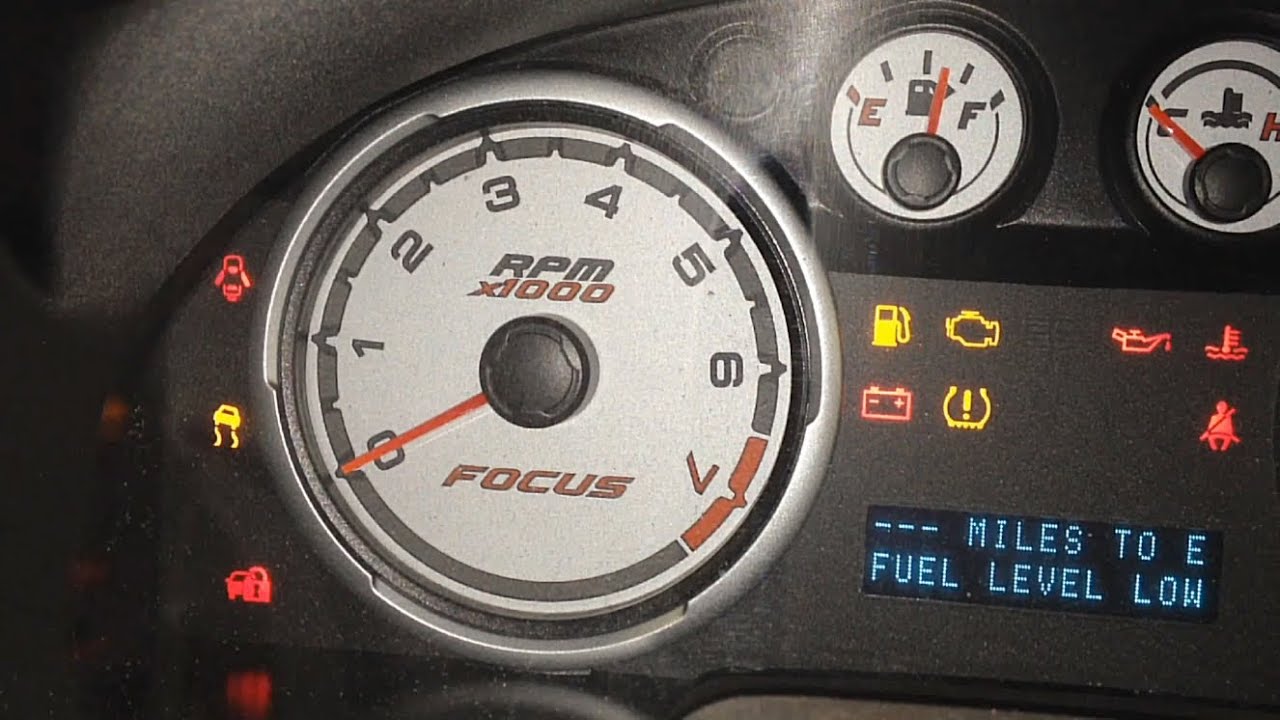If the theft light on the 2003 Ford Mustang is on, it typically indicates an issue with the vehicle’s Passive Anti-Theft System (PATS). This could be due to a damaged key, a weak key fob battery, a malfunctioning transceiver, or even a problem with the PCM.
If you’re driving a 2003 Ford Mustang and notice the theft light on the dashboard illuminated or blinking, it’s more than just a simple warning—it’s likely an indicator of an issue with the vehicle’s anti-theft system. The Ford Mustang, particularly from the early 2000s, comes equipped with the Passive Anti-Theft System (PATS), which is designed to prevent unauthorized access to the vehicle.
However, when something goes wrong with the system, it can prevent the car from starting, causing frustration. Identifying why the theft light is on and how to fix it is important for getting the Mustang back on the road.
In this article, we’ll explain reasons why the theft light might be illuminated on the 2003 Ford Mustang, how to diagnose the issue, and steps you can take to resolve the problem.

Contents
- 1 Passive Anti-Theft System (PATS)
- 2 Common Causes for the Theft Light to Illuminate
- 3 Diagnosing and Fixing the Theft Light Issue
- 4 How to Reset the Anti-Theft System
- 5 Frequently Asked Questions
- 6 Conclusion
Passive Anti-Theft System (PATS)
The Passive Anti-Theft System (PATS) in the 2003 Ford Mustang is designed to prevent unauthorized starting of the car. It works by embedding a unique transponder chip into the key. When you insert the key into the ignition and turn it, the vehicle’s Powertrain Control Module (PCM) communicates with the chip in the key. If the key’s code matches the one stored in the PCM, the system will allow the car to start.
If there’s an issue with the system—whether it’s a problem with the key, the PCM, or another component—the theft light will illuminate or blink, indicating that the car’s anti-theft system is preventing the engine from starting.
Common Causes for the Theft Light to Illuminate
If the theft light on the 2003 Ford Mustang is on, it means the vehicle’s anti-theft system has detected an issue that is preventing the engine from starting. Understanding the common causes of this issue can help you diagnose and fix the problem efficiently.
1. Key or Transponder Issues
One of the most common reasons for the theft light coming on is a problem with the key or transponder. The key contains a small transponder chip that communicates with the vehicle’s computer to allow it to start. If the chip in the key is damaged, misplaced, or worn out, the system may fail to recognize the key, and the theft light will turn on.
Symptoms:
- The theft light blinks when the key is inserted.
- The car refuses to start or cranks but doesn’t turn on.
- The engine doesn’t start after several attempts.
Causes:
- Worn-out or damaged key: The key can become damaged over time due to wear and tear.
- Mismatched transponder: If the transponder chip inside the key is damaged, the system won’t recognize it.
Solution:
- Try using a spare key to see if the issue persists.
- Inspect the key for physical damage and consider getting a replacement from a Ford dealership or locksmith.
2. Weak or Dead Key Fob Battery
For Mustangs equipped with remote keyless entry, the key fob has a built-in chip that communicates with the PATS system. If the battery inside the key fob is weak or dead, the system may not recognize the key, and the theft light will turn on. This can prevent the car from starting or result in intermittent starting issues.
Symptoms:
- The theft light flashes or stays on even with a new key inserted.
- The car starts intermittently or not at all.
Causes:
- Weak or dead battery in the key fob: The PATS system relies on communication with the key fob, and a weak battery can hinder this process.
Solution:
- Replace the battery in the key fob and test the key again.
- If the key still isn’t recognized, you may need to reset the key fob or get a new one programmed.
3. Faulty PATS Transceiver
The PATS transceiver is responsible for receiving the signal from the key and transmitting it to the PCM. If the transceiver is malfunctioning, it may fail to properly communicate with the key’s transponder chip, causing the theft light to turn on and preventing the car from starting.
Symptoms:
- The theft light stays on or flashes continuously.
- The engine does not start even with a functional key.
Causes:
- Faulty transceiver: If the transceiver is damaged or malfunctioning, the car won’t recognize the key.
Solution:
- The PATS transceiver needs to be inspected and replaced if necessary. A qualified mechanic can diagnose and replace the faulty part.
4. Electrical or Wiring Issues
Loose, corroded, or damaged wiring and electrical connections in the PATS system can disrupt communication between components, leading to the theft light coming on. This can be a more complex issue, as it involves diagnosing and fixing the wiring connections.
Symptoms:
- Intermittent starting issues.
- The theft light flickers on and off.
- No response when attempting to start the car.
Causes:
- Loose or corroded connections: Electrical connections in the PATS system may degrade over time, leading to inconsistent functionality.
- Worn-out wiring: If the wiring to the transceiver or PCM is damaged, it can affect communication.
Solution:
- Inspect the wiring in the ignition system and PATS system for any signs of damage or corrosion.
- Repair or replace damaged wires as necessary.
5. PCM (Powertrain Control Module) Problems
The PCM is the brain of the vehicle’s engine and anti-theft system. In rare cases, the PCM may malfunction and fail to properly recognize the key’s transponder signal, causing the theft light to stay on.
Symptoms:
- The theft light stays illuminated continuously.
- The car cranks but doesn’t start, even with a recognized key.
Causes:
- Faulty PCM: If the PCM is damaged or has a software issue, it may fail to communicate with the key’s transponder chip.
Solution:
- The PCM may need to be reprogrammed or replaced. This is a more complex repair and may require a visit to a Ford dealership or an experienced mechanic.

Diagnosing and Fixing the Theft Light Issue
If the theft light remains on and the Mustang won’t start, it’s important to perform a thorough diagnosis to identify the underlying cause. Below are some steps you can take to troubleshoot and potentially resolve the issue before seeking professional help.
1. Check the Key and Key Fob
If the theft light on the 2003 Ford Mustang is on, it means the vehicle’s anti-theft system has detected an issue that is preventing the engine from starting. Knowing the common causes of this issue can help you diagnose and fix the problem efficiently.
2. Perform a Key Reset
Try resetting the system by turning the key to the “ON” position for 10-12 minutes without starting the engine. This can sometimes help the system recognize the key and allow the car to start.
3. Check the Wiring and Connections
Inspect the wiring related to the PATS system. Ensure there are no loose or corroded connections. A professional mechanic can also perform a more thorough inspection of the system.
4. Use an OBD-II Scanner
Use an OBD-II scanner to check for any diagnostic trouble codes (DTCs) related to the PATS system. This can help identify any issues with the PCM, transceiver, or other components.
5. Consult a Professional
If the issue persists and you’ve exhausted all troubleshooting steps, it’s best to consult a professional mechanic or visit a Ford dealership. A technician can run a full diagnostic to pinpoint the issue and recommend the necessary repairs.
How to Reset the Anti-Theft System
If the theft light remains on, you can attempt to reset the PATS system using the following methods:
Method 1: The 10-Minute Key Cycle Reset
- Insert the key into the ignition and turn it to the “ON” position without starting the engine.
- Leave the key in the “ON” position for 10-12 minutes.
- After 10 minutes, turn the key to the “OFF” position and remove it.
- Try starting the car with the key.
Method 2: The Multiple Cycle Method
- Insert the key and turn it to the “ON” position.
- Turn the key back to the “OFF” position.
- Repeat the cycle eight times within 10 seconds.
- On the eighth cycle, leave the key in the “ON” position for 3 seconds, then attempt to start the car.
Related Article
Why Does Rear Disk Stick on 96 Mustang GT?
Why Is My Mustang Shaking?
Why Is the Eleanor Mustang Called Eleanor?
Frequently Asked Questions
Here are some FAQs about 2003 Ford Mustang theft light On –
1. Why is my 2003 Ford Mustang theft light blinking?
The blinking theft light indicates that the PATS system has detected an issue with the key or transponder and is preventing the engine from starting.
2. How can I reset the anti-theft system on my 2003 Mustang?
You can try resetting the system using the 10-minute key cycle reset or the multiple cycle method, as described above.
3. Can a weak key fob battery cause the theft light to stay on?
Yes, a weak or dead key fob battery can prevent the system from recognizing the key, causing the theft light to stay on.
4. What should I do if my Mustang won’t start and the theft light is on?
Try using a spare key, replacing the fob battery, and performing the reset methods. If the issue persists, seek professional help.
5. Can I disable the PATS system on a 2003 Mustang?
Disabling the PATS system is not recommended, as it is an important security feature of the vehicle.
Conclusion
If your 2003 Ford Mustang’s theft light is on, it’s essential to identify that the Passive Anti-Theft System (PATS) is likely preventing the car from starting due to an issue with the key, transponder, or other components of the system. By diagnosing the problem carefully—whether it’s a damaged key, dead fob battery, or faulty transceiver—you can address the issue and get your Mustang back on the road.




